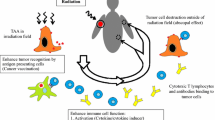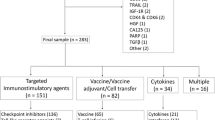Abstract
Background
Interest in harnessing the power of the host immune system to combat breast cancer recently has gained significant momentum. A growing body of evidence suggests that combined radiation therapy (RT) and immunotherapy synergistically activate a systemic immune response.
Methods
A review of original research, pre-clinical, retrospective, and prospective clinical studies was performed to assess the existing evidence to support a role for combined immunoradiotherapy in the treatment of breast cancer.
Results
Substantial evidence supports a synergism in combined immunoradiotherapy approaches. In this role, RT serves not only as a potent mediator of local control but also as an important component of systemic disease control. Actively accruing clinical trials aim to further define the clinical impact of immunoradiotherapeutic approaches in breast cancer.
Conclusions
This review provides an overview of the interplay between RT and emerging oncoimmunotherapy strategies and provides a biological explanation for their synergy in the treatment of breast cancer. More robust nationally funded studies are indicated.

Similar content being viewed by others
References
Group EBCTC (2011) Effect of radiotherapy after breast-conserving surgery on 10-year recurrence and 15-year breast cancer death: meta-analysis of individual patient data for 10 801 women in 17 randomised trials. Lancet 378:1707–1716
Ahmed MM, Guha C, Hodge JW, Jaffee E (2014) Immunobiology of radiotherapy: new paradigms. Radiat Res 182:123–125
Reits EA, Hodge JW, Herberts CA et al (2006) Radiation modulates the peptide repertoire, enhances MHC class I expression, and induces successful antitumor immunotherapy. J Exp Med 203:1259–1271
Obeid M, Panaretakis T, Joza N et al (2007) Calreticulin exposure is required for the immunogenicity of γ-irradiation and UVC light-induced apoptosis. Cell Death Differ 14:1848–1850
Apetoh L, Ghiringhelli F, Tesniere A et al (2007) Toll-like receptor 4-dependent contribution of the immune system to anticancer chemotherapy and radiotherapy. Nat Med 13:1050–1059
Ghiringhelli F, Apetoh L, Tesniere A et al (2009) Activation of the NLRP3 inflammasome in dendritic cells induces IL-1β-dependent adaptive immunity against tumors. Nat Med 15:1170–1178
Schaue D, Micewicz ED, Ratikan JA, Xie MW, Cheng G, McBride WH (2015) Radiation and inflammation. In: Seminars in radiation oncology; 2015. Elsevier. p. 4–10
Golden EB, Frances D, Pellicciotta I, Demaria S, Helen Barcellos-Hoff M, Formenti SC (2014) Radiation fosters dose-dependent and chemotherapy-induced immunogenic cell death. Oncoimmunology 3, e28518
Demaria S, Ng B, Devitt ML et al (2004) Ionizing radiation inhibition of distant untreated tumors (abscopal effect) is immune mediated. Int J Radiat Oncol Biol Phys 58:862–870
Formenti SC, Demaria S (2009) Systemic effects of local radiotherapy. Lancet Oncol 10:718–726
Vatner RE, Formenti SC (2015) Myeloid-derived cells in tumors: effects of radiation. In: Seminars in radiation oncology; 2015. Elsevier. p. 18–27
Dunn GP, Bruce AT, Ikeda H, Old LJ, Schreiber RD (2002) Cancer immunoediting: from immunosurveillance to tumor escape. Nat Immunol 3:991–998
Pinedo H, Buter J, Luykx-de Bakker S et al (2003) Extended neoadjuvant chemotherapy in locally advanced breast cancer combined with GM-CSF: effect on tumour-draining lymph node dendritic cells. Eur J Cancer 39:1061–1067
Formenti S, Friedman K, Chao K et al (2008) Abscopal response in irradiated patients: results of a proof of principle trial. Int J Radiat Oncol Biol Phys 72:S6–S7
Apostolopoulos V, Pietersz GA, Tsibanis A et al (2006) Pilot phase III immunotherapy study in early-stage breast cancer patients using oxidized mannan-MUC1 [ISRCTN71711835]. Breast Cancer Res 8:R27
Dewan MZ, Vanpouille-Box C, Kawashima N et al (2012) Synergy of topical toll-like receptor 7 agonist with radiation and low-dose cyclophosphamide in a mouse model of cutaneous breast cancer. Clin Cancer Res 18:6668–6678
Dewan MZ, Galloway AE, Kawashima N et al (2009) Fractionated but not single-dose radiotherapy induces an immune-mediated abscopal effect when combined with anti–CTLA-4 antibody. Clin Cancer Res 15:5379–5388
Kwon ED, Drake CG, Scher HI et al (2014) Ipilimumab versus placebo after radiotherapy in patients with metastatic castration-resistant prostate cancer that had progressed after docetaxel chemotherapy (CA184-043): a multicentre, randomised, double-blind, phase 3 trial. Lancet Oncol 15:700–712
Azuma T, Yao S, Zhu G, Flies AS, Flies SJ, Chen L (2008) B7-H1 is a ubiquitous antiapoptotic receptor on cancer cells. Blood 111:3635–3643
Dong H, Strome SE, Salomao DR et al (2002) Tumor-associated B7-H1 promotes T-cell apoptosis: a potential mechanism of immune evasion. Nat Med 8:793–800
Brahmer JR, Tykodi SS, Chow LQ et al (2012) Safety and activity of anti-PD-L1 antibody in patients with advanced cancer. N Engl J Med 366:2455–2465
Muenst S, Schaerli A, Gao F et al (2014) Expression of programmed death ligand 1 (PD-L1) is associated with poor prognosis in human breast cancer. Breast Cancer Res Treat 146:15–24
Ghebeh H, Barhoush E, Tulbah A, Elkum N, Al-Tweigeri T, Dermime S (2008) FOXP3+ Tregs and B7-H1+/PD-1+ T lymphocytes co-infiltrate the tumor tissues of high-risk breast cancer patients: implication for immunotherapy. BMC Cancer 8:57
Zhang P, Su D-M, Liang M, Fu J (2008) Chemopreventive agents induce programmed death-1-ligand 1 (PD-L1) surface expression in breast cancer cells and promote PD-L1-mediated T cell apoptosis. Mol Immunol 45:1470–1476
Liyanage UK, Moore TT, Joo H-G et al (2002) Prevalence of regulatory T cells is increased in peripheral blood and tumor microenvironment of patients with pancreas or breast adenocarcinoma. J Immunol 169:2756–2761
Wang L, Li D, Fu Z, Li H, Jiang W, Li D (2007) Association of CTLA-4 gene polymorphisms with sporadic breast cancer in Chinese Han population. BMC Cancer 7:173
Hodi FS, O’Day SJ, McDermott DF et al (2010) Improved survival with ipilimumab in patients with metastatic melanoma. N Engl J Med 363:711–723
Robert C, Long GV, Brady B et al (2015) Nivolumab in previously untreated melanoma without BRAF mutation. N Engl J Med 372:320–330
Wolchok JD, Kluger H, Callahan MK et al (2013) Nivolumab plus ipilimumab in advanced melanoma. N Engl J Med 369:122–133
Postow MA, Callahan MK, Barker CA et al (2012) Immunologic correlates of the abscopal effect in a patient with melanoma. N Engl J Med 366:925–931
Formenti SC, Demaria S (2013) Combining radiotherapy and cancer immunotherapy: a paradigm shift. J Natl Cancer Inst. djs629
Matsumura S, Wang B, Kawashima N et al (2008) Radiation-induced CXCL16 release by breast cancer cells attracts effector T cells. J Immunol 181:3099–3107
Demaria S, Kawashima N, Yang AM et al (2005) Immune-mediated inhibition of metastases after treatment with local radiation and CTLA-4 blockade in a mouse model of breast cancer. Clin Cancer Res 11:728–734
Lugade AA, Sorensen EW, Gerber SA, Moran JP, Frelinger JG, Lord EM (2008) Radiation-induced IFN-γ production within the tumor microenvironment influences antitumor immunity. J Immunol 180:3132–3139
Leavy O (2015) Immunotherapy: a triple blow for cancer. Nat Rev Cancer 15(5):258–259
Gulley JL, Arlen PM, Bastian A et al (2005) Combining a recombinant cancer vaccine with standard definitive radiotherapy in patients with localized prostate cancer. Clin Cancer Res 11:3353–3362
Park JW, Melisko ME, Esserman LJ, Jones LA, Wollan JB, Sims R (2007) Treatment with autologous antigen-presenting cells activated with the HER-2–based antigen lapuleucel-T: results of a phase I study in immunologic and clinical activity in HER-2–overexpressing breast cancer. J Clin Oncol 25:3680–3687
Mittendorf E, Clifton G, Holmes J et al (2014) Final report of the phase I/II clinical trial of the E75 (nelipepimut-S) vaccine with booster inoculations to prevent disease recurrence in high-risk breast cancer patients. Annals of Oncology mdu211
Le DT, Wang-Gillam A, Picozzi V et al (2015) Safety and survival with GVAX pancreas prime and Listeria monocytogenes–expressing mesothelin (CRS-207) boost vaccines for metastatic pancreatic cancer. J Clin Oncol: JCO. 2014.57. 4244
Teh BS, Aguilar-Cordova E, Vlachaki MT et al (2002) Combining radiotherapy with gene therapy (from the bench to the bedside): a novel treatment strategy for prostate cancer. Oncologist 7:458–466
Kawashita Y, Ohtsuru A, Kaneda Y et al (1999) Regression of hepatocellular carcinoma in vitro and in vivo by radiosensitizing suicide gene therapy under the inducible and spatial control of radiation. Hum Gene Ther 10:1509–1519
Stevens CW, Zeng M, Cerniglia GJ (1996) Ionizing radiation greatly improves gene transfer efficiency in mammalian cells. Hum Gene Ther 7:1727–1734
Teh BS, Aguilar-Cordova E, Kernen K et al (2001) Phase I/II trial evaluating combined radiotherapy and in situ gene therapy with or without hormonal therapy in the treatment of prostate cancer—a preliminary report. Int J Radiat Oncol Biol Phys 51:605–613
Teh BS, Ayala G, Aguilar L et al (2004) Phase I–II trial evaluating combined intensity-modulated radiotherapy and in situ gene therapy with or without hormonal therapy in treatment of prostate cancer—interim report on PSA response and biopsy data. Int J Radiat Oncol Biol Phys 58:1520–1529
Fujita T, Teh BS, Timme TL et al (2006) Sustained long-term immune responses after in situ gene therapy combined with radiotherapy and hormonal therapy in prostate cancer patients. Int J Radiat Oncol Biol Phys 65:84–90
Ayala G, Satoh T, Li R et al (2006) Biological response determinants in HSV-tk+ ganciclovir gene therapy for prostate cancer. Mol Ther 13:716–728
Chhikara M, Huang H, Vlachaki MT et al (2001) Enhanced therapeutic effect of HSV-tk+GCV gene therapy and ionizing radiation for prostate cancer. Mol Ther 3:536–542
Funding
No source of funding is associated with this article.
Compliance with ethical standards
ᅟ
Conflict of interest
The authors declare that they have no competing interests.
Ethical approval
This article does not contain any studies with human participants or animals performed by any of the authors.
Author information
Authors and Affiliations
Corresponding author
Rights and permissions
About this article
Cite this article
Farach, A., Farach-Carson, M.C., Butler, E.B. et al. The role of combined radiation and immunotherapy in breast cancer treatment. J Radiat Oncol 4, 347–354 (2015). https://doi.org/10.1007/s13566-015-0216-5
Received:
Accepted:
Published:
Issue Date:
DOI: https://doi.org/10.1007/s13566-015-0216-5




